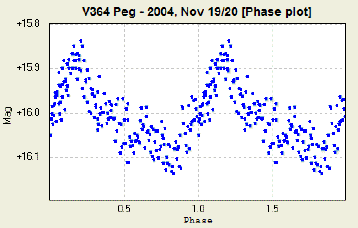 |
 |
 |
|
 |
| |
|
V364 Peg
- a new UGSU-type dward nova near the period gap
Following Patrick Schmeer's
announcement [cba-news, dd. Nov 19, 2004] of
an outburst detection of V364 Peg, on CCD images
taken on Nov 19.088 UT, I started an unfiltered
time-series photometry session on this object, at
CBA Belgium Observatory. Observations were made
between 17h UT (Nov 19, 2004) and 21h35m UT,
yielding a total of 193 CCD images, using an SBIG
ST-7XME camera.

V364 Peg light curve on Nov
19/20, 2004 based on unfiltered CCD observations,
obtained at CBA Belgium Observatory
The resulting light curve (see
above) clearly shows the presence of well developed
superhumps with an amplitude of about 0.3 mag. This
securely classifies V364 Peg as a new member of
the UGSU-type dwarf novae. Using the ANOVA period
determination method of Peranso,
I find a superhump period of 0.0882 +/- 0.0070 d
(2.12 hours), which is *very* close to the lower
limit of the so called period gap.
|
 |
|
 |
|
ANOVA period
window yielding superhump period of 0.0882 d. |
|
Phase
diagram for V364 Peg |
V364 Peg was discovered during the
supernova survey at the Beijing Astronomical
Observatory [Qiu et al. IAUC, No. 6746].
The object was classified as a suspected UGSU-type
dwarf nova, based on a limited set of observations
obtained at Kyoto University on Nov 19, 1997 [IBVS
4776], showing an hump-like feature. Due to the
limited timespan of the observations, the article
was not conclusive on the superhump period neither.
Given the long orbital period of
this dwarf nova, it is an interesting target for
follow-up observations
|
|
|
 |
|
 |
|
|
 |
Copyright © 2004 - Tonny Vanmunster.
|
 |
|
 |